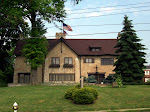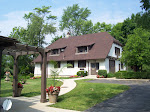Luckily, the Mahoning Valley Historical Society is a member of the Intermuseum Conservation Association located in Cleveland. This is a fantastic facility with world class conservators. Several pieces were taken to ICA for evaluation and restoration.
One of the pieces was a portrait of William Rayen from the early 1800's. Water ran down the back side of the canvas and caused the varnish to blanch, seen in the first picture.
 The paintings conservator removed the painting from the frame, and removed the blanched varnish with an isopropanol alcohol. By examining the paint layers under magnification and in ultraviolet light, the conservator also determined that there was previous retouching done to the black paint of the coat and to the face.
The paintings conservator removed the painting from the frame, and removed the blanched varnish with an isopropanol alcohol. By examining the paint layers under magnification and in ultraviolet light, the conservator also determined that there was previous retouching done to the black paint of the coat and to the face.
After all the varnish was removed, some retouches were made and the portrait was given a protective spray, felting to protect the canvas edges, and new hardware for hanging.
In order to understand the significance of the portrait to the MVHS collection, one must realize the contributions Rayen made in the early history of Youngstown.
William Rayen
William Rayen was born in 1776 in Kent County, Maryland. He and his wife Margaret Caree Rayen operated a mercantile in Westmoreland County, Pennsylvania from approximately 1796-1799, before settling in the Mahoning Valley before 1802. Rayen also operated a tavern and mercantile in Youngstown, during that time, he became involved in politics and other local businesses. He served as postmaster from 1818 to 1839, keeping the post office in the store. He was township clerk in 1816, justice of the peace after 1819, and associate judge of the court of common pleas after 1820. He was a stockbroker and director of the Pennsylvania and Ohio Canal Company. In 1819 he helped form an agricultural society and became its secretary. He cultivated his own land and orchards during most of his life. William and Margaret had two children, both of whom died before reaching adulthood. Margaret Rayen died in 1826, William in 1854.
 William Rayen's Store
William Rayen's StoreWilliam Rayen opened the first public house in Youngstown, Rayen's Tavern, in 1802. Ten years later, he opened a store at the corner of Federal and Holmes (present-day Fifth Avenue), and did business there for twenty-five years, most of the time in partnership with James Mackey. "Rayen and Mackey" closed in 1837.
This image is a page from one of Rayen's daybooks.
Youngstown’s First High School

When William Rayen died in 1854, his will set aside $31,390 for a public academy to be known as “The Rayen School.” P. Ross Berry, an African American brick and stone mason, built the four-room brick building at the corner of Wick and Wood in the Greek Revival style of architecture. It opened its doors in 1866 with forty students and a predominantly female faculty. It graduated Youngstown’s first high school students several years later. The Rayen School was the city’s only high school until 1911. This image is the original building ca. 1870.

+small.jpg)





1 comment:
William Rayen’s home: I was wondering if William Rayen’s home is still standing? Are the any pictures of it?
Post a Comment